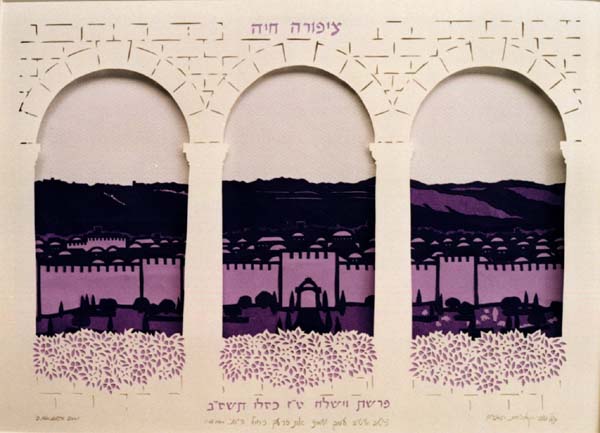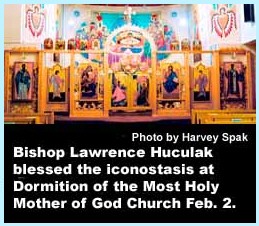| THREE
It's roots stem from the meaning of multiplicity. Creative power; growth.
Three is a moving forward of energy, overcoming duality, expression,
manifestation and synthesis. Three is the first number to which the meaning
"all" was given. It is The Triad, being the number of the whole as it contains
the beginning, a middle and an end.
The power of three is universal and is the tripartide nature of the world
as heaven, earth, and waters. It is human as body, soul and spirit. Notice
the distinction that soul and spirit are not the same. They are not. Three
is birth, life, death. It is the beginning, middle and end. Three is a complete
cycle unto itself. It is past, present, future.
The symbol of three is the triangle. Three interwoven circles or triangles
can represent the indissoluble unity of the three persons of the trinity.
Others symbols using three are: trident, fleur-de-lis, trefoil, trisula,
thunderbolt, and trigrams.
The astral or emotional body stays connected to the physically body for
three days after death. There is scientific evidence that the brain, even
when all other systems are failing takes three days to register complete
shutdown.
Three: Total of the first two numbers: 1+2=3. Most noticeable in the Trinity
the three fold nature which governs the universe. The three-fold nature of
man: mind, body and soul. Leaves should always be depicted in threes for
the Trinity. Steps on a cross in threes for Faith, Hope and Charity.
There are 3 phases to the moon. Lunar animals are often depicted as 3
legged.
Three is the heavenly number, representing soul, as four represents body.
Together the two equal seven (3+4=7 ) and form the sacred hebdomad. The 3x4=12
representing the signs of the Zodiac and months of the year.
Pythagorean three means completion.
|
The
Three Pillars and 10 Sepherioth of the Kaballah
Kabbalism - Mazal
- Wisdom |
Symbols and
Doors
Mosque of the Three
Doors
Three and the Kaballah
Symbols |
| About The Three Doors
We daily engage in all sorts of activity -- mentally, physically, verbally
-- all propelled by the causes and conditions we ourselves have built up
through this life and even lifetime upon lifetime. We think, say and do all
kinds of things that we might regret or, at least, have no control over.
The medium of these activities is called the "Three Doors," Body, Speech
and Mind.
. We are Sirius A, B and C. After Sirius A implements the supernatural
heliacal tidal wave and shift... then the femenine principle will return,
this is called Het Heru/Auset in Khemet and the Shekinah in kaballah. Same
earth different dimension. |
|
|
| Within the solar symbolism each door is a special gateway. The north
is winter solstice, the south is summer solstice, and the center opens onto
Heaven.
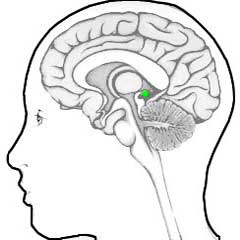 
By using the analogy of inversion, we notice that a psychic center is
located in each human being, yet there is only one center. We can visualize
this concept by seeing humans placed on the surface of the earth. The center
in each person is a radius to the center of the earth, and so of the
universe.
|
| Christians and Jews are familiar with the fact that king Solomon called
on Hiram, the Tyrian architect, to build his temple. It is now known that
the temple was none other than a copy of a Phoenician temple of the period,
likely that of Melqart in Tyr. The sanctuary was rectangular and tripartite,
built on a platform that had an East-West orientation. Oriental sanctuaries
followed the plan of common dwellings, as the sanctuary was considered to
be a residence, and the Temple was no exception. In front of the entrance
were erected two 12-meter-tall columns of bronze that played no structural
role. In Phoenician lore they would represent the two columns that supported
the world; right now they have made their way all the way into Tarot cards,
where they are represented as black and white and refer to the Two Pillars
of the Qabalistic Tree of Life. The decoration of the cedar wood that lined
the inside was identical to that found on Phoenician ivories: it included
pomegranates (a symbol of fertility to the Phoenicians), palmettes (recalling
the tree of life) and winged sphinxes (protective forces). The cult accessories
were also the kind that was found in all contemporary Phoenician sanctuaries
?a golden altar, the bread table, 10 candle holders etc. The "sea of bronze"
was also cast by Hiram's team of Phoenician engineers.
At this point we step into the allegorical part of Hiram's story. It
may be based on real events, but the elements that have come to us are obviously
symbolic rather than real.
Hiram's workers were divided in three groups: apprentices, companions
and masters. On paydays they presented themselves to the temple with the
password revealed by Hiram. The apprentices met around the J column (Jachim),
the companions around the B column (Boaz), and the masters in the central
room.
Hiram's flock counted three black sheep: a mason named Jebulas, a carpenter
named Jubelos, and a minor named Jubelum. They wanted to obtain the grade
(and salary) of masters without going through the required stages. Planning
to coerce Hiram into promoting them, they took place at the three doors of
the temple and waited for him. When Hiram came to the South gate Jubelas
made his demand, and as it was refused he hit Hiram with his ruler, aiming
for the throat (it is noted that he missed and the blow reached the shoulder).
Hiram ran to the West gate and the same scene happened with Jubelos, whereas
Hiram received the blow of an iron square to the left side of his chest.
He fled to the East gate and Jubelum hit him to the forehead with his mallet,
killing him on the spot.
From a Masonic point of view, the tools of the crime and the parts of
the body that were hit are highly symbolic. The ruler stands for precision,
the square for rectitude, and the mallet for will. Hiram was hit at the throat,
seat of material life, at the heart, seat of the soul, and at the forehead,
seat of intelligence. As for the three assassins, they are the three banes
of progress: lie, ignorance and ambition.
FROM:
www.cedarseed.com/articles/pyth-hiram.html
|
|
CHARTRES CATHEDRAL
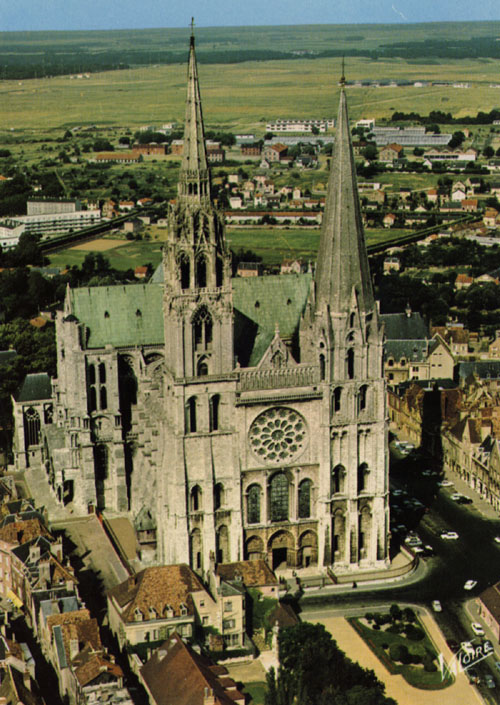 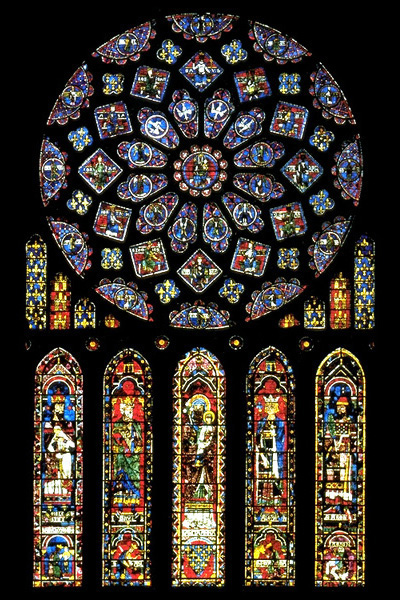
Chartres Cathedral is one of the great works of humanity.
THE TEMPLE
Cathedral of Chartres, is a great temple in the world, meant as a symbol
of the home of God. We are the pivot point between above and below, and as
we look at the external temple, we have the choice to find within a mirror
image, an internal temple. In fact the internal temple is the real one -
the external one is just a whole lot of stone.
SECRET KNOWLEDGE
Here I am not referring to Freemasonry, but to the idea that there has
been knowledge kept secret, spiritual knowledge, and in particular knowledge
of the secrets of art and architecture. After the age of the cathedrals,
the Middle Ages, with the Renaissance, and up to the present, the development
of humanity in the European tradition turned to the development of the intellect,
reason, logical thought, as distinct from instinct and intuition. We have
gained enormously from this development, and we can see with a clarity previously
impossible, but a combination of ego and rationality has demanded an
understanding which commands its subject. An illusory desire for reason to
command all, meeting the fact that reason cannot command all, produces the
concept of secrets, secret knowledge. There is an essential knowledge, but
it is not secret, just difficult to put into practice, so it is sometimes
easier to hold the concept of secret knowledge, not available to me.
There have been all sorts of ideas about secret schools preserving knowledge
of architecture across the centuries, and this usually settles upon geometrical
systems of proportion and composition. Harmonious proportions and number
symbolism were used, but only as a part of a repertoire of expressive techniques,
and these harmonies are inherent in the human mind, and emerge naturally
when composition is undertaken by a pure mind. There is absolutely no evidence
that the cathedrals are the product of a tradition of secret knowledge -
the secrets of the guilds are mostly trade secrets about mortar mixes, the
geometry of structure, how to make glass, how to cut stone, and similar craft
matters. The search for secret knowledge is often promoted by people who
are avoiding their own self discovery. There have been times when knowledge
had to be kept secret from oppressive authorities - time when religious
institutions were both decadent and powerful, but even then the real knowledge
can be expressed in a way that communicates without offence.
HISTORICAL OUTLINE
When Roman civilisation collapsed early in the Christian era, centuries
of chaos ensued, centuries in which the craft of building was all but lost.
After about the first millennium, conditions stabilised in France, partly
through the expansion of monasticism, and gradually building skill was revived,
so that by the middle of the twelfth century, the great Romanesque churches
were being built all over Europe. A new craft tradition had been established
in architecture. During this period, the Greek classics were also gradually
being introduced into European culture, so that a strand of Neoplatonic idealism
was being blended with Christian contemplative mysticism. Thus there was
available a sound craft tradition and a people who included mystics who did
have that insight into their real nature. That was the social context. What
about the local context at Chartres?
LEGENDS OF CHARTRES
There are legends about Chartres that go back to before any church was
built. At least they purport to do so, but in fact none of them is recorded
at all before about the fourteenth century, long after the present cathedral
was built. Nevertheless, whether or not they have physical
truth, they have now assumed a psychological truth that is in some respects
more real than physical truth. Chartres was said to have been a centre of
Druid worship for centuries before Christ, with a grotto and holy well where
the virgin birth of a divine figure were celebrated. There is still a well
in the crypt, which until the Revolution was the home of an ancient wooden
statue of the Virgin Mary, which was brought out on ceremonial occasions,
clearly symbolic of birth, and these rites seem to continue pre-Christian
ceremonies. It can be added here that Chartres has no tombs, so that it is,
probably uniquely, a church not of death, but of birth. The next legend is
that after the crucifixion, Joseph of Arimathea came to Chartres, and finding
there centre of worship of a virgin birth of divinity, sent word back to
Mary to ask if he might dedicate a church to her there. Chartres is thus
said, according to this legend, to be the first church dedicated to the Virgin
Mary.
LABYRINTH
There is another strand in this idea offered by the labyrinth on the
floor of the cathedral, as in many other Medieval churches, a labyrinth similar
to types found all over the world, from all periods. It is a circular path
on the floor of the nave, not a confusing maze, but a single path which follows
complex convolutions through eleven circles to the centre. It is widely held
to represent the spiritual life-journey of the aspirant. However, until the
Revolution, there was in the centre a plate with on it pictures of Theseus,
Ariadne, and the Minotaur. In pre-classical times, King Minos of Crete required
tribute from Athens, and every seven years he demanded seven young men and
seven young women to be put into the labyrinth in which was kept the Minotaur,
a monster who would then kill and eat them. Theseus demanded to be included
with the fourteen, and when he reached Crete, the daughter of Minos, Ariadne,
fell in love with him, and gave him a ball of thread, given her by the builder
of the maze, which would not only lead him to the Minotaur, whom he could
thus surprise and kill, but also lead him out. Although nothing is known
of the church's use of the maze, it has been suggested that the relevance
was that Theseus was rescued from his trial in the darkness by the help of
the virgin Ariadne, as the church hold all are helped in the trials in the
darkness of life by the Virgin Mary.
There is a very web of symbolism here, for the labyrinth represents at
once an ascent to the light and a trial in the darkness, and also, in the
darkness, the birth of redemption, using an aspect of the feminine side of
human nature. The journey into the light is the same as the journey into
the dark. The real explanation of the marvels of Chartres will emerge more
from mythological understanding than from rational analysis, which is always
trying to explain the whole from a part. Ideas like this were familiar to
the early Gothic builders.
Chartres Cathedral and the Abbey of St Denis, near Paris, were the two
buildings tha transformed architecture. Architecture had collapsed during
the Dark Ages, and over the period of the revival of civilisation and culture,
skill was regained, and a new tradition established. In a flash of inspiration,
Abbot Suger of St Denis realized that this tradition could be drawn into
new heights of performance in building a church that not only housed the
functions of the liturgy, but actually inspired people into a deeper spiritual
consciousness, and this he put into practice when the Abbey Church was rebuilt
in about 1140. Unusually for the time, he wrote at length about his experiences,
motivation and inspiration. He put this verse over the door of the church:
Whoever you are, if you seek to fathom the good in these doors
Then marvel not at the gold or the cost, but find the aim of the artist.
This noble art has a hidden light that can lift the mind in an inward way
It warms the heart, to turn from daily concern to heaven within,
And opens the door to truth in each of us.
Such art can show how the spirit within can be found in this world:
The dull mind rises to truth through material things,
And seeing this light escapes its former submersion.
Chartres
|
| Some Trinitarian churches have three doors, appropriately, as entrances.
Synagogues, if you have not noticed, typically have five doors, one for each
book of the Torah, the Mosaic Law. It is literally a house of the Book. When
you enter through the doors, you study Mosaic Law
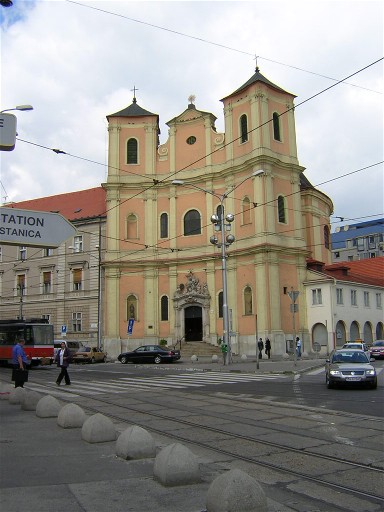
BRATISLAVA
BULGARIA
Iconostasis: (Gr. eikonostasion, eidonostasis, picture screen, from eikon,
image, picture, and histemi, place), the chief and most distinctive feature
in all Greek churches, whether Catholic or Orthodox. It may be said to
differentiate the Greek church completely from the Roman in its interior
arrangement. It consists of a great screen or partition running from side
to side of the apse or across the entire end of the church, which divides
the sanctuary from the body of the church, and is built of solid materials
such as stone, metal, or wood, and which reaches often (as in Russia) to
the very ceiling of the church, thus completely shutting off the altar and
the sanctuary from the worshipper. It has three doors: the great royal door
in the middle (so called because it leads directly to the altar upon which
the King of kings is sacrificed), the deacon's door to the right, and the
door of the proskomide (preparation for Liturgy) upon the left, when viewing
the structure from the standpoint of a worshipper in the body of the
church.
|
| Ibrihami Mosque in Hebron
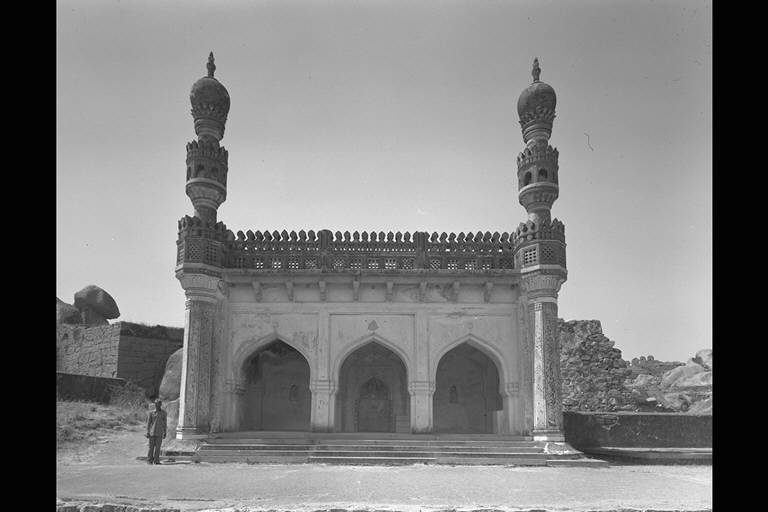
Desecration and Usurpation of the Ibrahimi Mosque
Recent Incident of desecration and Usurpation of the Ibrahimi Mosque (The
Records of the Islamic Higher Council, Jerusalem)
May 27, 1982 Jewish settlers, putting wine on a table to prevent Muslims
from praying in the Ibrahimi Mosque.
June 2, 1982 The preparations for prayer by Jewish settlers in the
Ibrahimi
Mosque, by the knowledge of the Israeli military Governor.
June 13, 1982 A wedding by Jewish Settler trespassers at the Mosque from
6 p.m until midnight.
July 1, 1982 Jewish settler trespassers brought iron cupboards and chairs
into the Jacobite and Ibrahimi tomb rooms inside the Ibrahimi Mosque.
September 13, 1982 Israeli soldiers prevented Muslims from holding their
dawn prayers.
September 27, 1982 Jewish settlers blew on the ram’s horn to disrupt
the moon, afternoon and sunset Muslim prayers.
October 24, 1982 Jewish settlers brought Hebrew manuscripts in frames
into the Ibrahimi and Jacobite tomb rooms, as part of their attempt to chance
the Ibrahimi Mosque into a synagogue.
November 27, 1982 Those responsible for the Ibrahimi Mosque were informed
that Jews would place the Toran inside the mosque, as part of their attempt
to change the Mosque into a synagogue.
November 29, 1982 Two hundred Jewish settlers broke into the Ibrahimi
Mosque at night, bringing tables and bottles of Coke into the Jacobite and
Yusifyeh tomb rooms.
December 16, 1982 Soldiers placed a candlestick on the Salah Eddin Ayubi
citadel, close to the Ibrahimi Mosque, and then brought a gas stove into
the mosque.
December 18, 1982 Israeli soldiers brought a dining table into the Ibrahimi
Mosque and ate their lunch.
January 29, 1983 Jewish settlers drank wine in the Ibrahimi Mosque.
February 28, 1983 After finishing their prayers inside the Ibrahimi Mosque,
Jewish settlers damaged the copper crescent on Lady Rifqa’s window.
April 16, 1983 Jewish settlers held a circumcision ceremony inside the
Ibrahimi Mosque, drinking wine and partying in desecration if Islamic standards.
May 1, 1983 Jewish settlers held a circumcision ceremony inside Ibrahimi
Mosque and Israeli military forces prevented Muslims from visiting the Ibrahimi
tomb.
September 9, 1983 An officer broke a door leading to the Mosque's minaret
and damaged the microphone. Then he made a path for Jews to enter on Muslim
carpets.
November 2, 1983 Jewish settlers put a table and chair in the pulpit,
changing the area into a religious school.
November 23, 1983 Jewish settlers hung the Ten Commandments in the Ibrahimi
and Jacobite tomb rooms as part of their attempt to transform the Mosque
into a synagogue.
December 29, 1983 Jewish settlers prevented Muslims from entering the
Mosque until late morning, as a way of asserting their claim to control the
Ibrahimi mosque.
Janueary 11, 1984 The Military Governor hung three copper pieces holding
the Ten Commandment on the three doors of Ibrahimi Mosque, as part of the
attempt to transform the Mosque into a synagogue.
A peace treaty with Jordan was signed in 1994, and a year later, the
Oslo Two accord was initialled in Cairo; peace for Israel and a state for
the Palestinians seemed to be just over the horizon. But it wasn’t long
before rejectionists on both sides were dictating events.
In February 1995, a lone Jewish gunman, Baruch Goldstein, massacred thirty
Palestinian worshippers at the Ibrihami Mosque in Hebron.
|
| Commentary On: Genesis 12:1 - 15:21
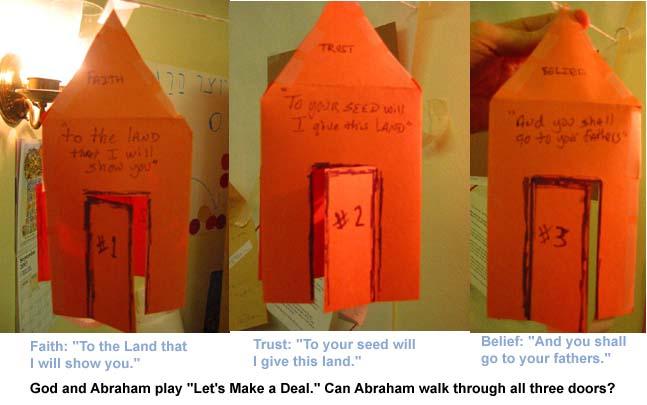
FROM:
http://torahquest.org/show_commentary.php?cid=79®id=160
Genesis 12
The Call of Abram
1 The LORD had said to Abram, "Leave your country, your people and your
father's household and go to the land I will show you. 2 "I will make you
into a great nation and I will bless you; I will make your name great, and
you will be a blessing. 3 I will bless those who bless you, and whoever curses
you I will curse; and all peoples on earth will be blessed through you."
4 So Abram left, as the LORD had told him; and Lot went with him. Abram
was seventy-five years old when he set out from Haran. 5 He took his wife
Sarai, his nephew Lot, all the possessions they had accumulated and the people
they had acquired in Haran, and they set out for the land of Canaan, and
they arrived there. 6 Abram traveled through the land as far as the site
of the great tree of Moreh at Shechem. At that time the Canaanites were in
the land. 7 The LORD appeared to Abram and said, "To your offspring [1] I
will give this land." So he built an altar there to the LORD , who had appeared
to him. 8 From there he went on toward the hills east of Bethel and pitched
his tent, with Bethel on the west and Ai on the east. There he built an altar
to the LORD and called on the name of the LORD . 9 Then Abram set out and
continued toward the Negev.
Abram in Egypt
10 Now there was a famine in the land, and Abram went down to Egypt to
live there for a while because the famine was severe. 11 As he was about
to enter Egypt, he said to his wife Sarai, "I know what a beautiful woman
you are. 12 When the Egyptians see you, they will say, 'This is his wife.'
Then they will kill me but will let you live. 13 Say you are my sister, so
that I will be treated well for your sake and my life will be spared because
of you."
14 When Abram came to Egypt, the Egyptians saw that she was a very beautiful
woman. 15 And when Pharaoh's officials saw her, they praised her to Pharaoh,
and she was taken into his palace. 16 He treated Abram well for her sake,
and Abram acquired sheep and cattle, male and female donkeys, menservants
and maidservants, and camels.
17 But the LORD inflicted serious diseases on Pharaoh and his household
because of Abram's wife Sarai. 18 So Pharaoh summoned Abram. "What have you
done to me?" he said. "Why didn't you tell me she was your wife? 19 Why did
you say, 'She is my sister,' so that I took her to be my wife? Now then,
here is your wife. Take her and go!" 20 Then Pharaoh gave orders about Abram
to his men, and they sent him on his way, with his wife and everything he
had.
Genesis 13
Abram and Lot Separate
1 So Abram went up from Egypt to the Negev, with his wife and everything
he had, and Lot went with him. 2 Abram had become very wealthy in livestock
and in silver and gold.
3 From the Negev he went from place to place until he came to Bethel,
to the place between Bethel and Ai where his tent had been earlier 4 and
where he had first built an altar. There Abram called on the name of the
LORD .
5 Now Lot, who was moving about with Abram, also had flocks and herds
and tents. 6 But the land could not support them while they stayed together,
for their possessions were so great that they were not able to stay together.
7 And quarreling arose between Abram's herdsmen and the herdsmen of Lot.
The Canaanites and Perizzites were also living in the land at that time.
8 So Abram said to Lot, "Let's not have any quarreling between you and
me, or between your herdsmen and mine, for we are brothers. 9 Is not the
whole land before you? Let's part company. If you go to the left, I'll go
to the right; if you go to the right, I'll go to the left."
10 Lot looked up and saw that the whole plain of the Jordan was well watered,
like the garden of the LORD , like the land of Egypt, toward Zoar. (This
was before the LORD destroyed Sodom and Gomorrah.) 11 So Lot chose for himself
the whole plain of the Jordan and set out toward the east. The two men parted
company: 12 Abram lived in the land of Canaan, while Lot lived among the
cities of the plain and pitched his tents near Sodom. 13 Now the men of Sodom
were wicked and were sinning greatly against the LORD .
14 The LORD said to Abram after Lot had parted from him, "Lift up your
eyes from where you are and look north and south, east and west. 15 All the
land that you see I will give to you and your offspring [1] forever. 16 I
will make your offspring like the dust of the earth, so that if anyone could
count the dust, then your offspring could be counted. 17 Go, walk through
the length and breadth of the land, for I am giving it to you."
18 So Abram moved his tents and went to live near the great trees of Mamre
at Hebron, where he built an altar to the LORD .
Genesis 14
Abram Rescues Lot
1 At this time Amraphel king of Shinar, [1] Arioch king of Ellasar,
Kedorlaomer king of Elam and Tidal king of Goiim 2 went to war against Bera
king of Sodom, Birsha king of Gomorrah, Shinab king of Admah, Shemeber king
of Zeboiim, and the king of Bela (that is, Zoar). 3 All these latter kings
joined forces in the Valley of Siddim (the Salt Sea [2] ). 4 For twelve years
they had been subject to Kedorlaomer, but in the thirteenth year they rebelled.
5 In the fourteenth year, Kedorlaomer and the kings allied with him went
out and defeated the Rephaites in Ashteroth Karnaim, the Zuzites in Ham,
the Emites in Shaveh Kiriathaim 6 and the Horites in the hill country of
Seir, as far as El Paran near the desert. 7 Then they turned back and went
to En Mishpat (that is, Kadesh), and they conquered the whole territory of
the Amalekites, as well as the Amorites who were living in Hazazon Tamar.
8 Then the king of Sodom, the king of Gomorrah, the king of Admah, the
king of Zeboiim and the king of Bela (that is, Zoar) marched out and drew
up their battle lines in the Valley of Siddim 9 against Kedorlaomer king
of Elam, Tidal king of Goiim, Amraphel king of Shinar and Arioch king of
Ellasar-four kings against five. 10 Now the Valley of Siddim was full of
tar pits, and when the kings of Sodom and Gomorrah fled, some of the men
fell into them and the rest fled to the hills. 11 The four kings seized all
the goods of Sodom and Gomorrah and all their food; then they went away.
12 They also carried off Abram's nephew Lot and his possessions, since he
was living in Sodom.
13 One who had escaped came and reported this to Abram the Hebrew. Now
Abram was living near the great trees of Mamre the Amorite, a brother [3]
of Eshcol and Aner, all of whom were allied with Abram. 14 When Abram heard
that his relative had been taken captive, he called out the 318 trained men
born in his household and went in pursuit as far as Dan. 15 During the night
Abram divided his men to attack them and he routed them, pursuing them as
far as Hobah, north of Damascus. 16 He recovered all the goods and brought
back his relative Lot and his possessions, together with the women and the
other people.
17 After Abram returned from defeating Kedorlaomer and the kings allied
with him, the king of Sodom came out to meet him in the Valley of Shaveh
(that is, the King's Valley).
18 Then Melchizedek king of Salem [4] brought out bread and wine. He was
priest of God Most High, 19 and he blessed Abram, saying,
"Blessed be Abram by God Most High,
Creator of heaven and earth.
20 And blessed be God Most High,
who delivered your enemies into your hand."
Then Abram gave him a tenth of everything.
21 The king of Sodom said to Abram, "Give me the people and keep the goods
for yourself."
22 But Abram said to the king of Sodom, "I have raised my hand to the
LORD , God Most High, Creator of heaven and earth, and have taken an oath
23 that I will accept nothing belonging to you, not even a thread or the
thong of a sandal, so that you will never be able to say, 'I made Abram rich.'
24 I will accept nothing but what my men have eaten and the share that belongs
to the men who went with me-to Aner, Eshcol and Mamre. Let them have their
share."
Genesis 15
God's Covenant With Abram
1 After this, the word of the LORD came to Abram in a vision:
"Do not be afraid, Abram. I am your shield, your very great reward. "
2 But Abram said, "O Sovereign LORD , what can you give me since I remain
childless and the one who will inherit [3] my estate is Eliezer of Damascus?"
3 And Abram said, "You have given me no children; so a servant in my household
will be my heir."
4 Then the word of the LORD came to him: "This man will not be your heir,
but a son coming from your own body will be your heir." 5 He took him outside
and said, "Look up at the heavens and count the stars-if indeed you can count
them." Then he said to him, "So shall your offspring be."
6 Abram believed the LORD , and he credited it to him as righteousness.
7 He also said to him, "I am the LORD , who brought you out of Ur of the
Chaldeans to give you this land to take possession of it."
8 But Abram said, "O Sovereign LORD , how can I know that I will gain
possession of it?"
9 So the LORD said to him, "Bring me a heifer, a goat and a ram, each
three years old, along with a dove and a young pigeon."
10 Abram brought all these to him, cut them in two and arranged the halves
opposite each other; the birds, however, he did not cut in half. 11 Then
birds of prey came down on the carcasses, but Abram drove them away.
12 As the sun was setting, Abram fell into a deep sleep, and a thick and
dreadful darkness came over him. 13 Then the LORD said to him, "Know for
certain that your descendants will be strangers in a country not their own,
and they will be enslaved and mistreated four hundred years. 14 But I will
punish the nation they serve as slaves, and afterward they will come out
with great possessions. 15 You, however, will go to your fathers in peace
and be buried at a good old age. 16 In the fourth generation your descendants
will come back here, for the sin of the Amorites has not yet reached its
full measure."
17 When the sun had set and darkness had fallen, a smoking firepot with
a blazing torch appeared and passed between the pieces. 18 On that day the
LORD made a covenant with Abram and said, "To your descendants I give this
land, from the river [4] of Egypt to the great river, the Euphrates- 19 the
land of the Kenites, Kenizzites, Kadmonites, 20 Hittites, Perizzites, Rephaites,
21 Amorites, Canaanites, Girgashites and Jebusites."

http://www.schgochurch.va.goarch.org/
Source: From Palestine and Syria. Handbook for Travelers by Karl Baedeker,
5th Edition, 1912
|
| God Deeded Ancient Israel Land To Today's Jews?
By Joseph Grant Swank
God said to Abraham that the geography of Israel would always belong to
him, that is, Abraham’s descendants. Such would then follow down to
today.
Therefore, some conservative Christians hold that anything less than that
fulfillment in present-day Israel is less than the divine covenant. Consequently,
those Christians push for political workage that would implement that
prophesy.
This future agenda is particularly meaningful to those Christians today
in the light of Sharon meeting with his Palestinian opposition. These Christians
yearn for all political parties, including Washington, to bend toward the
divine plan.
In other words, since God said it, it has to be. Since God said it, anything
else is counterproductive and bound to failure. Therefore, on with the divine
program for that alone will eventuate anyhow. Why waste precious time? Get
on with the plan set in revelatory print. It eventually is bound to be
anyway.
However, there are those conservative Christians who do not agree with
this at all. They understand where their fellow believers are coming from
— the Bible. And they understand the significance of prophecy fulfillment.
They also have the same high regard for divine revelation as their fellow
believers; however they do not hold to the same conclusion, that is, that
the promise to Abraham has to come to pass literally before the close of
the present age.
The latter conservative believers state that since Jews in times much
later than Abraham disobeyed God, they thereby lost their deed to the land.
These Christians state that the Jews of the latter Old Testament period so
prostituted their place before God that they thereby broke the divine promises.
In other words, the promises were conditioned on the people of God being
an obedient people.
God called out a people. They were to His chosen ones, not to be pampered
and spoiled, but to see through His holy mission of gospeling the nations
surrounding them. The Old Testament "called out ones" obviously did not get
the message. They continued to disobey the very Jehovah who had laid before
them such marvelous promises. Their continued disobedience frustrated the
divine. His patience was constantly strained. Yet in His mercy, He called
back the wayward ones in hopes that each new generation would see the holy
light.
Finally, when the Jews persisted in sin generation upon generation, outrightly
disobeying God’s clear commands to holiness, God severely disciplined
them. So it was that Babylonians and Assyrians conquered the Jews and their
land. So it was that the temple was ravaged, its holy furnishings were stolen
and Jews themselves taken captive.
In other words, by disobedience persisting, Jews lost their "chosen people"
status. They had defined the label to mean other than being called to mission
the holy message of Jehovah; therefore, they paid the painful consequences
of eventuating as the wandering, captured peoples of pagan regimes.
Since then, the promises regarding Abraham’s original land have been
snapped, not by God, but by the Jews. Just as the Jews lost their temple,
finally in AD 70 by Roman General Titus when he leveled the temple and Jerusalem,
so they have lost their deed to the ancient boundaries.
10.27.03
|
| Early Synagogues
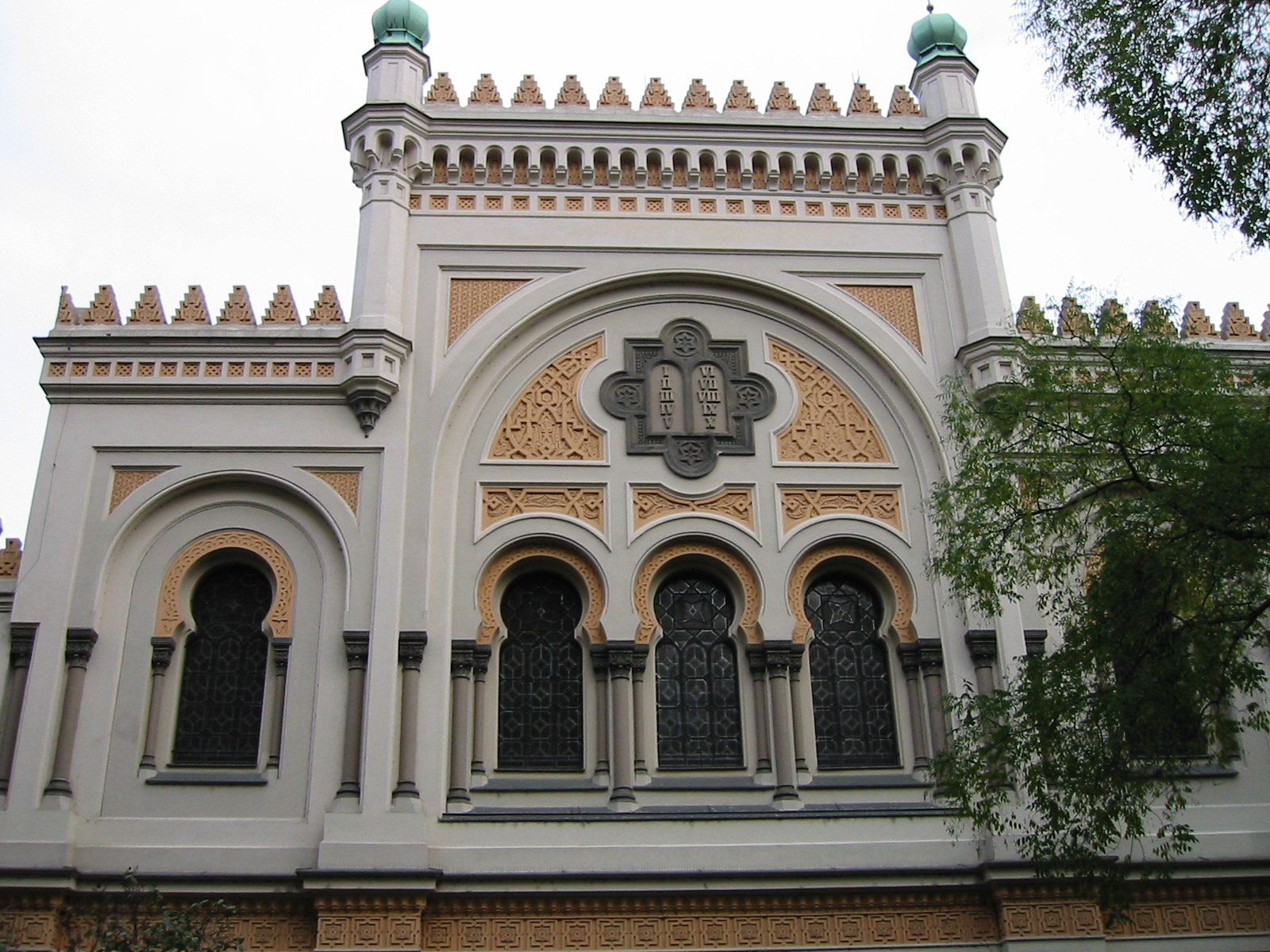
SPANISH SYNAGOGUE
Synagogues continued to be a focal point for Jewish life during the first
century. By the time Jesus’ ministry began, a synagogue was found in
most towns of Galilee. The Gospels specifically mention those of Nazareth
(Matt. 13:54) and Capernaum (Mark 1:21). Archaeologists have found scant
evidence of these early synagogues, although later synagogues left substantial
remains. Only one synagogue dating to Jesus’ time has been uncovered,
in the town of Gamla.
Typically, synagogues were placed in prominent places—on an elevated
platform or high place— symbolizing the importance of living in God’s
presence. In some cases, the front facade had three doors. And outside each
synagogue was a mikveh (ritual bath), where worshipers symbolically cleansed
their hearts before entering the synagogue.
Inside the synagogue, important people sat on benches, called chief seats,
which lined three sides of the room (Matt. 23:6). Common people sat on the
floor, which was usually made of dirt or flagstones (or elaborate mosaics
in later synagogues). Speakers and readers would stand on a small platform,
the bema. And a small menorah, like the one in the Temple, probably stood
there as well.
Torah readers sat in a special place called the Moses’ Seat (or Seat
of Honor), so named because they were reading Moses’ words (Matt. 23:2).
Torah scrolls and the writings of the prophets were either kept in a portable
chest that was brought to the synagogue for worship or were stored in a permanent
Torah cabinet (called the Torah closet or holy ark) inside the synagogue.
See:
http://community.gospelcom.net/Brix?pageID=1633
|
THE MIDDLE PILLAR MEDITATION

THE MIDDLE PILLAR
"The Secret of Wisdom can be discerned only from the place of balanced
power" (2) - that is from between the two temple pillars. Poise at a third
point, which neutralizes to some extent the violence of the swing of the
psychic pendulum from one extreme to the other, is the result of cultivating
equanimity representing an equal capacity to be either at rest or active,
interested or withdrawn at will, and not from emotional compulsion. This
central point between the two symbolic pillars of the opposites, the place
of balanced power from which the working of the opposites may correctly be
viewed, is the implication of Daath, which is the name of this shadowy Sephirah.
Rightly it is shadowy and the word is used advisedly for in the majority
of us who have not culti vated the difficult art of avoiding the opposites,
the development of this new principle has proceeded with the utmost slowness.
It is a new factor of adaptation or equilibrium, especially between the two
broad divisions of consciousness - the ego on the one hand with its desire
for adjustment to modem life with its refined and non-natural conditions,
and on the other hand with the superficial levels of the instinctual life,
concerned with primitive things, of self-assertion and the unbridled
gratification of its every whim and caprice. It is this new factor of adjustment
which comprises the principal impetus to what has been variously called in
the east the Golden Flower, and in mediaeval Europe the growth of the Red
Rose upon the Cross of Gold. (3) It is the Stone of the Philosophers, the
medicine of metals. (4) To the four central Sephiroth plus the shadowy Daath
as the fifth, are attributed divine names - which, as in the former exercise,
are to be vibrated powerfully in conjunction with the imaginative formulation
of various images. With each of these five centers there is associated a
divine name to be used as a vibratory formula. The attributions as we have
received them, together with the traditional name of the Sephiroth, are given
below with the names of the principles active in the human psyche. The numberings
are those that appear on the Tree. (6)
Kether - Yechidah
"AHIH" (pronounced "Eh-he-yeh")
Daath - The Link
"YHVH ALHIM" ("Ye-hoh-voh E-loh-heem") (7)
Tiphareth - Ruach
"YHVH ALOAH ve-DAATH" ("Ye-hoh-voh El-oah ye Da-ath" ) (8)
Yesod - Nephesh
"SHADDAI AL CHAI" ("Shah-dai El Chai") (9)
Malkuth - Body
"ADNI HARTZ" ("Ah-doh-nai ha-Ah-retz")
The divine names and the names of the Sephiroth should naturally be committed
to memory of their position or relation to parts of the human frame.
Kether, the first Sephirab, is a center of light, and in the Qabalistic
Cross, it is attributed to a center posited slightly above the crown of the
head. It refers to that higher genius or it which, not yet fully incarnated
within, broods above, a silent watcher. It is for each of us the source of
inspiration and freedom and enlightenment. It is life itself.
Daath, the shadowy Sephirah, which develops in the course of evolution
as we learn the domination of our mental and emotional propensities, is situated
at the nape of the neck. Its position is at a point on the spine just below
the occiput, about one or two inches above the larynx, and its diameter may
be imagined to be about four inches in extent. It is conceived to be a symbolic
link, self-induced and self-devised, between the higher genius on the one
hand, and on the other, the ego, the conscious self referred to that group
of characteristics clustered around Tiphareth.
On the Middle Pillar, Daath connects the higher faculties to the ego,
Kether to Tiphareth. This latter Sephirah is resident in the neigh borhood
of the heart, and its sphere extends from the diaphragm or solar plexus more
or less to the spine. Its center may be imagined to be the lowest point of
the sternum or breast-bone to which the ribs are attached, its diameter being
about six inches.
Below Tiphareth is Yesod, a center which is referred to the region occupied
by the generative organs, and its size should be visual ized as of the same
dimensions as Tiphareth. The final center is Malkuth, referred to the feet,
and it will be found by experience that the ankles comprise the periphery
of a visualized sphere about four inches or so in diameter, the center being
the sole of the foot.
The method of working this practice called the Middle Pillar is to stand
upright, hands to side, eyes closed, breath being inhaled and expired steadily.
Above all the mind should be quiet, calm, and still. When familiarity with
the exercise is obtained, it may be per formed sitting or lying down. These
preliminary conditions being fulfilled, let the student begin by transferring
his attention to that region immediately above the crown of his head, where
he should endeavor to visualize a sphere of white brilliance. To accomplish
this may take some little while. Several attempts may be required before
any realization of this center occurs. But when it has been obtained, let
it be regarded with a certain sense of devotion, and contemplated as being
the spatial correlative or correspondence of the vital core of his being.
This devotional attitude should enliven it considerably, and the sense of
light and power, the first avenues of sense by which this higher phase of
consciousness may be grasped, should increase wholly beyond anticipation.
At this juncture let him vibrate three or four times, slowly the name Eheieh.(10)
This is a Hebrew divine name meaning "I am" (or more accurately "I will be")
a statement which in reality is all that one can truthfully say of the self.
Every other characteristic and quality belongs not to its own intrinsic nature
but to the vehicles and sheaths of con sciousness through which it
functions.
THE FULL BREATHING
EXERCISE
|
| Major methods of Jewish meditation include:
(Explanatory learning pages are being added for each method, watch for
hyperlinks)
Chanting of verses
from psalms, Torah and prayers.
Focusing upon a Shviti - a special Jewish graphic which helps induct a
mystical state of consciousness.

This type of papercut is often referred to as a "shviti," a form
of mizrach whose name comes from the verse,"Sh'viti Hashem
l'negdi tamid," "I will keep God at the forefront of my mind at all
times." This verse is seen in the circles at the top of the papercut.
Below the lions and menorah is a verse from Ashrei, which is
recited three times daily, "God is close to those who call upon him, to
those who call upon him sincerely."
(Psalm 145:18)
(papercut 11.5" x
14.5") S004
[Beautiful example can be found on last
page of Art Scroll Tehillim.]
Meditation on the names of
God or on the letters of God's name.
Guided
visualizations.
Walking, dancing and movement meditations.
Focusing upon the levels of an external or inner flame.
Working with the "Tree of Life"/Sephirot, (A model based on personality
characteristic polarities,
which correlate in some ways with the chakra/meridian system and are designed
as a holographic paradigm.)
Attaining a state of "Eyin", the "no-state" which is all. Often through
attention to breath and silence.
Guided sounding of vowels or letters.
Study of ancient sacred Jewish texts, specially designed to induce mystical
encounter.
Becoming attuned to the power of special blessings in connecting us to
what mystics experience as "the river of light."
FROM:
http://www.rebgoldie.com/Meditation.htm
|
|
| Sacred geometry is the language of the creator... expressed
mathematically, and mathematics is the universal language,
by Vincent M. Bridges
http://www.vincentbridges.com/highweirdness/SaSWA.html
"One of the greatest scientific achievements imaginable would be the discovery
of an explicit relationship between the waveform alphabets of quantum theory
and certain human states of consciousness."
The works of such modern day Kabbalists by the author of "in Light in The
Meeting Tent" and J.J. Hurtak's Keys of Enoch suggest that we have indeed
found the pivotal point where consciousness, quantum mechanics and the Kabbalah
intersect. The question then becomes: Is that point the origin of the alphabet?
Although humanity has spawned thousands of languages, fewer than a dozen
instances of the invention of writing are recorded in human history. Most
of these occurred in or around the ancient Near East. Cuneiform script in
Sumer, Proto-Elamite in Caanan, and hieroglyphs in Egypt appeared roughly
at the same time, around 3000 BC. Cretan pictoglyphs and the Indus Valley
scripts are dated to around 2000 BC. Hittite hieroglyphs and Chinese pictograms
developed between 1700 and 1500 BC, as did the Semitic alphabet which would
eventually become, with the Chinese alphabet, the form by which all living
languages are written.
The Semitic alphabet developed, according to the best archeological evidence,
in the turquoise and gold mines of Sinai just after 1700 BC. Hieratic or
cursive Egyptian phonetic letters were applied to a proto-Semitic language.
We can easily read the Semitic word "b'lat," the goddess, in hieratic characters
on the quarry walls at Serabit El-Khadem in the Sinai. Similar developments
occurred over the next two hundred years throughout ancient Caanan. By 1400
BC, roughly the time of the Exodus of Moses, these trends had merged into
a form that scholars call the Caananite Linear alphabet. From this developed
all other alphabetic scripts, from Latin Gothic to Old Hebrew and Imperial
Aramaic, from Cyrillic to Kufic to Sanskrit and Amharic.
Logically, if any ancient alphabet could be called sacred, it must surely
be that original alphabetic source. Tradition would also suggest that the
origin of this sacred alphabet, the moment when the "flame letters" were
revealed, involved the conjunction of Egyptian and Semitic sources in the
Sinai. Working the mines where proto-sinatic inscriptions appear were the
Midianites of the Bible, the people with whom Moses lived while in exile
from Egypt. They were a Bedouin sort of people, pre-Yahweh Hebrews who worshipped
a nameless God on a mountain top. It was while tending his flocks on the
sacred mountain that Moses, the Egyptian prince, encountered the Burning
Bush. Moses, of course, eventually returned to the Midianites' sacred mountain
with a vast horde of wandering Semitic refugees to receive God's commandments;
carved, we are told, by the divine appendage on slabs of stone.
This experience, this direct, face-to-face encounter with divinity, was
the culmination of the Exodus. If any moment could be said to have been infused
with divine meaning, in an alphabetic sense, surely this was the moment.
Tradition also holds that Moses was the author of that first sentence in
Genesis, which was deciphered in 1968 as a geometric description
of a universal dissipative structure, the torus.
[Editors note: The name of the author is not presented here because of
search engines policy and fear of lawsuits by the author.]
8-9-00 - I decided I needed to ask
some questions especially what the difference between 'fire' and
'flame' letters are, if any, so I did. ...
www.greatdreams.com/frflmlrs.htm
|
'Alphabets of Light', also called
'Fire letters' or 'Flame letters' by several scholars are the
weights and measures recorded by Enoch used by other Creator ...
www.greatdreams.com/MIND/49levels.htm
|
FIRE AND FLAME LETTERS. MIRACLES OR
MASS HALLUCINATIONS? ... Reuchlin held that with the birth of Jesus,
the name of the Four letters had been rendered ...
www.greatdreams.com/miracle.htm |
"The Symbolism and Spiritual Significance of the Number Three"
GEMATRIA - SACRED GEOMETRY |
MOSES
THE MYSTERY AND CONTROVERSY
OF THE STORY OF MOSES - AKHENATEN
... In the new chronology of Egypt, the pharaoh on the throne of Egypt
was Neferhotep I of the 13th Dynasty. Moses and The Israelites. ... DATING
THE BIRTH OF MOSES. ...
The Symbolism
and Spiritual Significance of the Number 11
... 3 And it came to pass in the fortieth year, in the eleventh month,
on the first day of the month, that Moses spake unto all Israel...
THE HEBREW ALPHABET
THE
KABALLAH |
